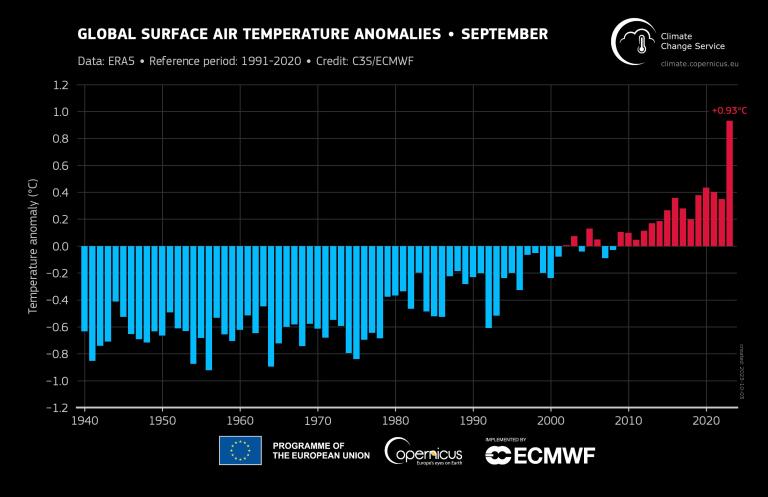September smashes monthly temperature record

This continues an extended streak of extraordinary land and sea-surface temperatures and is an ominous signal about the speed with which greenhouse gases are changing our climate. The year 2023 is now on track to be the warmest year on record, with June, July, August and September all breaking monthly temperature records.
The US National Oceanic and Atmospheric Administration said there is a greater than 99% probability that 2023 will rank as the warmest year on record. September was far and away the most atypically warm month of any in NOAA’s 174 years of climate keeping. September 2023 was warmer than the average July from 2001-2010.
NASA also confirmed that it was by far the warmest September.
North America, South America, Europe and Africa each had their warmest September on record. Asia had its second-warmest September, while September in Oceania ranked third warmest, according to NOAA’s National Centers for Environmental Information.
For the sixth consecutive month, September saw a record-high monthly global ocean surface temperature. September 2023 tied August 2023 for the highest monthly sea surface temperature anomaly (+1.85°F or +1.03°C) on record. Antarctica had its warmest September (and sea ice extent remained at seasonal record lows), and the Arctic had its second warmest September on record.
“Since June, the world has experienced unprecedented heat on land and sea. The temperature anomalies are enormous – far bigger than anything we have ever seen in the past. Antarctic winter sea ice extent was the lowest on record for the time of year. What is especially worrying is that the warming El Niño event is still developing, and so we can expect these record-breaking temperatures to continue for months, with cascading impacts on our environment and society,” said WMO Secretary-General Prof. Petteri Taalas.
“WMO will work with our partners in the scientific community to try to understand what additional factors are contributing to this exceptional warming,” said Prof. Taalas.
WMO combines six leading international datasets – including the C3S reanalysis (called ERA5), NOAA and NASA - for its climate monitoring activities. The WMO provisional State of the Global Climate 2023 will be released at the start of the UN climate change conference, COP28, in Dubai on 30 November.
News of the record-breaking September came as a new synthesis report from the UN Convention on Climate Change previewed Parties’ blueprint for decisions on the global stocktake at COP28.

The Paris Agreement sets long-term goals to guide all nations to substantially reduce global greenhouse gas emissions to limit the global temperature increase in this century to 2 °C while pursuing efforts to limit the increase even further to 1.5 °C, to avoid or reduce adverse impacts and related losses and damages.
The fact that an individual month, or year, exceeds the 1.5 °C limit does not mean that we have exceeded the 1.5°C level specified in the Paris Agreement because that refers to long-term warming over many years.
Other key points (C3S):
- The September 2023 global temperature was the most anomalous warm month of any year in the ERA5 dataset (back to 1940).
- September 2023 was 0.93°C warmer than the 1991-2020 baseline which is used as a practical tool for climate sensitive sectors like agriculture.
- The global temperature for January-September 2023 was 0.05°C higher than the equivalent period in the warmest calendar year (2016) and 1.40°C higher than the preindustrial average (1850-1900).
- Europe had its warmest September on record, at 1.1°C higher than 2020, the previous warmest September, with many national temperature records. The heat has continued into October.
- The average sea surface temperature for September over 60°S–60°N (the extrapolar ocean) reached 20.92°C, the highest on record for September and the second highest across all months, behind August 2023.
- El Niño conditions continue to develop over the equatorial eastern Pacific.
Sea Ice
- Antarctic sea ice extent remained at a record low level for the time of year.
- Both the daily and monthly extents reached their lowest annual maxima in the satellite record in September, with the monthly extent 9% below average.
- The daily Arctic Sea ice extent reached its 6th lowest annual minimum while the monthly sea ice extent ranked 5th lowest, at 18% below average.










